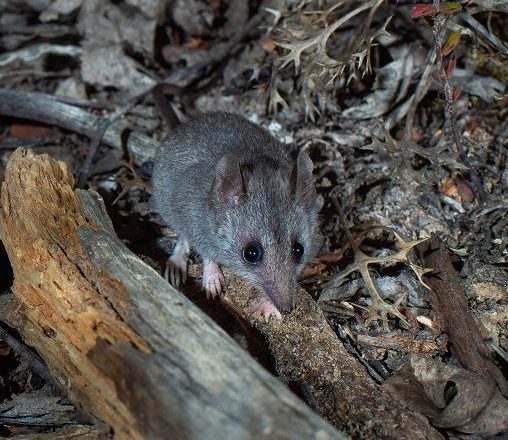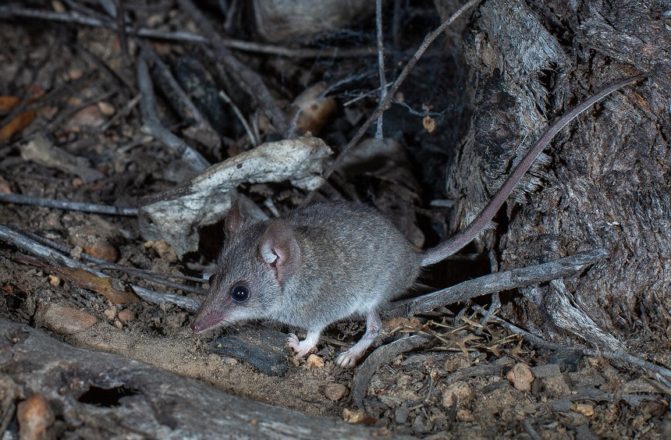The Kangaroo Island Dunnart is a small carnivorous marsupial found only on Kangaroo Island, South Australia. AWC is working with local landholders and conservation organisation, Kangaroo Island Land for Wildlife, to protect one of the surviving populations of the dunnart after extensive wildfires in late 2019 and early 2020 burnt 95 per cent of their habitat.


 © Brad Leue/AWC
© Brad Leue/AWC
Extensive wildfires in late 2019 and early 2020 burnt 95 per cent of the remaining habitat of the Kangaroo Island Dunnart. Fortunately, the dunnart persisted in unburnt patches of vegetation, but the population was reduced to perilously low levels.
Taking swift action, AWC joined forces with local landholders and conservation organisation, Kangaroo Island Land for Wildlife (KI LfW), to help protect this population and save the species from extinction.
The partnership established the Western River Refuge, launched in February 2021, which is jointly managed by AWC, KI LfW and private landholders. This safe haven protects over 369 hectares of critical habitat for the dunnart, and a suite of other threatened species, within an 8.8 kilometre long feral-predator proof fence. This initial stage of the project, enclosing 13.8 hectares of critical refuge, was completed in February 2020, following extensive collaborative feral predator management and ecological surveys.
 © Brad Leue/AWC
© Brad Leue/AWC
Historically, the main threat to the Kangaroo Island Dunnart was clearing of native vegetation to farmland, which has occurred across half the island. Wildfires in the remaining native vegetation is a serious threat, as most records of the dunnart are from long-unburnt vegetation. Feral cats occur on Kangaroo Island and can be presumed to hunt more effectively in recently burnt vegetation. The fenced feral cat-free area, constructed by AWC at Western River Refuge in partnership with local landholders and conservation organisation Kangaroo Island Land for Wildlife, is therefore critical to helping save the species.
 Wayne Lawler/AWC
Wayne Lawler/AWC
Description
The Kangaroo Island Dunnart is a small carnivorous marsupial, with a head-body length of 80 to 90 millimetres and a slightly longer tail (85 to 105 millimetres). Females weigh 10-15 grams (which is less than an Australian 50 cent coin), while males weigh 20 to 25 grams (roughly half a golf ball – about the same as a house mouse).
It has grey fur that is dark on the back and pale on the belly, a thin grey tail and pale – almost white – fur on the hands and feet. It has a slender pointed muzzle and large ears.
The Kangaroo Island Dunnart was initially considered a race of the Common Dunnart (Sminthopis murina), but following taxonomic revision was listed as a unique species (Sminthopsis aitkeni). Subsequent genetic analysis has shown the Kangaroo Island Dunnart is closely related to the Grey-bellied Dunnart (Sminthopsis griseoventer), which occurs on the mainland on the Eyre Peninsula, South Australia, as well as in south-west Western Australia. However, as Kangaroo Island has been isolated from the mainland for 10,000 years, the Kangaroo Island Dunnart is considered a distinct taxonomic entity. It is the only dunnart on Kangaroo Island.
The species has only been known to science for 50 years.
Ecology
Remarkably little is known about the Kangaroo Island Dunnart, as it has proved difficult to catch in pitfall traps (the standard method). When the recovery plan was written, in 2011, the dunnart had been captured a grand total of 35 times. The deployment of remote camera traps has resulted in additional records in the last few years across public and private conservation land.
Like other dunnarts, the Kangaroo Island Dunnart feeds primarily on small animals, mostly invertebrates (spiders, beetles, ants, etc). Within its range, it occupies a variety of native vegetation, both mallee and woodland, sheltering in grasstrees (Xanthorrhoea), leaf litter, and holes in the ground. The available data show that dunnarts forage 200 to 300 metres from their nest sites each night.
Breeding occurs from late spring into summer; like other small dasyurids, males are unlikely to outlive the breeding season, while females may survive a second year. Dunnarts have up to 10 young per litter.
Range and Abundance
The Kangaroo Island Dunnart is restricted to Kangaroo Island, South Australia. According to the Mammal Action Plan, the range extends over 160 square kilometres, of which 24 square kilometres are considered to be occupied.
Early records were from the eastern part of the island, but all recent records are from the west, which retains significant cover of native vegetation. Most records of the dunnart are associated with long unburnt vegetation.
Historical records from 1969 to 1976 reported that all Kangaroo Island Dunnart sightings from the central and eastern parts of the island were in areas where intensive land clearing was occurring. Its current distribution on Kangaroo Island is restricted to the western end of the Island within Flinders Chase National Park, Ravine des Casoars Wilderness Protection Area and areas of remnant native vegetation on private conservation land to the central west and north west.
Donate to help protect the Kangaroo Island Dunnart and other endangered species from extinction
Donate NowKoalas inhabit eucalypt forests and woodlands in eastern Australia from north Queensland through to south-east South Australia.
The Northern Brown Bandicoot is common on the east coast of Australia north from the Hawkesbury River up to the...